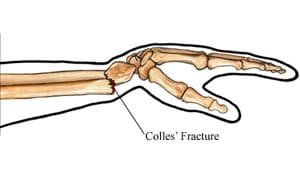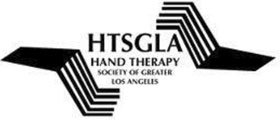*Also called CMC osteoarthritis, thumb OA, trapeziometacarpal arthritis
WRIST FRACTURES AND HAND FRACTURES (Broken wrist/broken hand)
A fracture is any type of break to a bone. One of the most common types of fractures is that of the distal radius, the larger bone on the thumb side of the forearm. These account for about 25% of fractures in children and up to 18% of all fractures in the elderly.1
Usually the break occurs about an inch above the wrist. One type of wrist fracture is a Colles fracture, where the bone fragment tilts toward the back of the hand .2

Whether you have sustained a Colles fracture or other hand fracture, for maximal recovery of hand function it is important to be assessed by a Hand Surgeon or Orthopedic surgeon. They will help you to determine the best course of treatment, whether casting alone, surgery to reduce the fracture through the use of pins, screws or plates, or application of an external fixator.
Rehabilitation can start as early as one week post-op with some procedures. Your arm will be assessed by your therapist, and a customized program will be designed for you. Because our therapists are specialists in treatment of the upper extremity, they are experienced in working with tissues soon after injury or surgery and are respectful of healing tissues. The early phase of therapy emphasizes control of swelling (edema), wound and scar management, and gentle exercises for the appropriate joints, in addition to protecting the healing fracture. You will be taught appropriate movements to keep joints moving and tendons and nerves gliding, based on your healing phase. No reason for fear, as we respect your pain as well as the healing tissues. This is NOT a “no pain, no gain” scenario. A custom thermoplastic splint may be fabricated for protection. This involves warming a low-temperature plastic material until it is putty-like, and forming it into a brace directly on your hand and forearm. Velcro is attached to hold it in place. It is easily removed and re-applied, allowing you to exercise and cleanse the skin.
As the weeks progress, your therapy program will progress as well, with frequent modifications to your home program. Strengthening will begin whenever the bone is sufficiently healed and swelling is mostly resolved. Getting you back to your normal activities – whether work, sport, recreation or music – is always our focus.
Feel free to call us with any questions, including referrals to Hand and Orthopedic Surgeons.
The staff of Hand Rehabilitation Specialists
1 The Epidemiology of Distal Radius Fractures Kate W. Nellans, MD, MPH,1 Evan Kowalski, BS,2 and Kevin C. Chung, MD, http://www.ncbi.nlm.nih.gov/pmc/articles/PMC3345129/
Tennis elbow (lateral epicondylitis, lateral epicondylosis) is a painful condition at the outside of the elbow, often occurring when tendons are overworked by repetitive motions of the wrist or arm. Surprisingly this is often caused by activities other than tennis.
The occupational and physical therapists at Hand Rehabilitation Specialists commonly treat tennis elbow with excellent results, whether for conservative treatment, post-operative rehabilitation, or post PRP therapy (platelet-rich plasma). Our goal is to allow the injured tissues to heal with flexibility and strength so that the arm can withstand life’s demands, whether sport, recreation, or work.
As always, we avoid a cookie-cutter approach. Each client is assessed for related disorders that can mimic tennis elbow, and an individual program is designed. A strength of our OT/PT team is our emphasis on activity modification: we work with our clients to determine the causes and perpetrating factors, and teach them how to modify those activities to reduce strain on the healing tissues and prevent recurrence. Ergonomic modifications for computer users, and technique modifications for musicians or athletes, are commonly addressed.
The therapy program may also include counterforce bracing (“tennis elbow bands”), custom wrist splints when necessary, soft tissue mobilization, active release, instrument-assisted soft tissue mobilization (aka Graston, SASTM, ASTYM), nerve gliding, muscle stretching, carefully-progressed strengthening at various muscle lengths, and modalities such as Light Therapy, ultrasound, electrical stimulation and iontophoresis with dexamethasone. A home exercise program is paramount and is constantly updated and progressed.
Our hand-to-shoulder expertise means that you can be assured of the highest quality treatment for your tennis elbow.
Golfer’s Elbow (medial epicondylitis, medial epicondylitis) is a comparable condition to tennis elbow and is treated similarly to the guidelines above.
What is it?
Carpal Tunnel Syndrome is a condition caused by compression of the median nerve at the wrist as it enters the hand – an area known as the Carpal Tunnel. In addition to the nerve, the Carpal Tunnel also houses 9 tendons that control finger and thumb motion. Increased pressure on the median nerve within the Carpal Tunnel may be due to repetitive motions of the wrist or digits, mechanical pressure, poor ergonomics, and/or secondary disorders such as hypothyroidism, rheumatoid arthritis, diabetes or pregnancy.
What are the symptoms?
Typical symptoms include numbness and tingling in the fingers (mainly thumb, index finger and middle finger – sometimes it feels like the whole hand), particularly at night or in the morning, but symptoms may be at any time during the day as well. You may also experience pain, weakness, cramping, or lack of coordination with fine motor tasks. Dropping items is a common complaint.
What can be done?
Carpal Tunnel Syndrome may be treated conservatively with great results, if caught early. At Hand Rehabilitation Specialists, our specialized Occupational and Physical Therapists will perform a thorough evaluation that may include strength, range of motion, function, sensation and ergonomic assessments.
A comprehensive therapy program will be customized to each individual with a focus on patient education to eliminate symptoms and ensure long-term success, rather than just treating the symptoms. Working with you to determine the likely cause – and then problem solving to eliminate the provocative factors – is an important part of the process. In addition, a wrist splint may be recommended, usually worn at night to support the wrist in a neutral position, taking pressure off the median nerve.
If you think you may have Carpal Tunnel Syndrome, it is important to seek out a doctor for an assessment and to address the symptoms as soon as possible. If this condition is left untreated, you may experience a gradual loss of strength and sensation that could possibly lead to permanent nerve damage.







